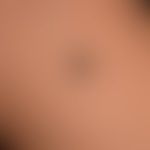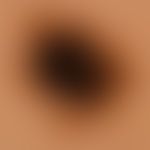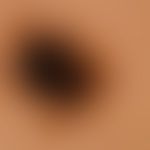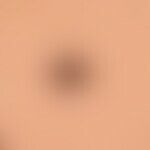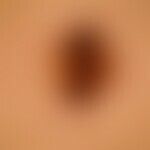Synonym(s)
HistoryThis section has been translated automatically.
DefinitionThis section has been translated automatically.
You might also be interested in
ManifestationThis section has been translated automatically.
LocalizationThis section has been translated automatically.
ClinicThis section has been translated automatically.
Mostly solitary (isolated reports of multiple occurrences), sharply circumscribed, 0.5 mm to 2.0 cm in size, hemispherically protuberant, round or oval, with a smooth shiny surface, light brown-reddish to blue-black nodule (or papule) interspersed with telangiectasias. The consistency is elastic to coarse.
Diascopic: Yellowish-brownish intrinsic infiltrate. Typical indication of rapid growth (within a few weeks!).
Reflected light microscopy: Characteristic reflected light features of Spitz nevi include zonular, cocard-like, or radial-striated basal architectures, annular or centrolesionally arranged areas of gray-black centropapillary globules or brown/black dots, scattered or ring-like peripheral gray-blue pseudopodia, perivasal melanophages, and inverse reticular patterns, especially in epithelioid cell nevi. In contrast to malignant melanomas, vascular polymorphisms, except in desmoplastic Spitz nevus, aneurysmal vascular outpouchings, and severe caliber variations as well as microscopic blood lakes are extremely rare. In some cases, perivasal melanophage agglomerates and bluish-gray pigment rings appear as internal mesh boundaries.
HistologyThis section has been translated automatically.
- Melanocytic nevus with 3 developmental phases (as with other melanocytic nevi):
- Naevus Spitz - Junction type
- Naevus Spitz - Compound type
- Naevus Spitz - dermal type.
- Tumours are usually symmetrical and sharply defined. Hyperplastic epidermis with orthokeratosis, hyperkeratosis, hypergranulose and acanthosis. Typical cleavage between melanocyte nests and surrounding keratinocytes. Cell polymorphies, mitoses and fish-like vertebrae of spindle cells are visible. Also epithelioid melanocytes with broad, homogeneous, eosinophilic cytoplasm are not rare. Multinucleated giant cells may occur. Mostly low pigmentation, but in individual cases massive. No destruction of the collagen fibres. Mitoses are found in the upper parts of the tumour, but not in the depth (important distinguishing feature from malignant melanoma). A typical feature are homogeneous, PAS-positive, light red globules (according to the first descriptor: kamino-bodies). The most important phenomenon of the Spitz nevus in demarcation to the malignant melanoma is the maturation of the melanocytes towards depth (as with other melanocytic nevi).
- Histological variants:
- Pigmented spindle cell nevus (reed): Here a uniform, strongly pigmented, spindle cell race predominates.
- Pigmented epithelioid cell nevus: Composed of nests of highly pigmented, large epithelioid cells.
- Granulomatous Spitz nevus: Predominantly dermal type. When magnified, the examiner is reminded of a sarcoid reaction.
- Plexiform Spitz nevus: Plexiform arrangement of predominantly spindle and epithelioid melanocytes.
- Desmoplastic Spitz nevus: Variant of a dermal Spitz nevus in which usually a few epithelioid melanocyte nests are located in a fibrosed dermis with broad, tangled collagenous fibre strands.
Differential diagnosisThis section has been translated automatically.
TherapyThis section has been translated automatically.
Excision in healthy individuals without a safety margin.
Progression/forecastThis section has been translated automatically.
TablesThis section has been translated automatically.
Feature |
Specificity [%] |
Sensitivity [%] |
Basic radial striate structure |
99 |
68 |
Zone or co-cardioid structure |
97 |
5 |
Isolated or ring-shaped peripheral grey-blue pseudopodia |
97 |
18 |
Annular or centroelastic areas with grey-black centropapillary globules |
89 |
25 |
Symmetrical structure |
80 |
88 |
Perivasal melanophages (especially epithelial cell nevi) |
n.a. |
n.a. |
Inverted Nez pattern (especially epithelioid cell nevi) |
n.a. |
n.a. |
Note(s)This section has been translated automatically.
Spitz tumors are biologically distinct from conventional melanocytic nevi and melanomas, as evidenced by their different patterns of genetic aberrations. While common acquired nevi and melanomas often show BRAF mutations, NRAS mutationsor inactivation of NF1 , Spitz tumors show HRAS mutations, inactivation of BAP1 (often in combination with BRAF mutations) or genomic rearrangements involving the kinases ALK, ROS1, NTRK1, BRAF, RET and MET. In Spitz nevi without significant histologic atypia, all of these mitogenic driver aberrations trigger rapid cell proliferation. After an initial growth phase, various tumor suppressive mechanisms stably block further growth. In some tumors, additional genomic aberrations can override various tumor suppressive mechanisms, e.g. cell cycle arrest, telomere shortening or the DNA damage response. The melanocytes then begin to grow in a less organized manner and can spread to regional lymph nodes, which is referred to as an atypical Spitz tumor. The sequential acquisition of genomic aberrations suggests that Spitz tumors represent a continuous biological spectrum rather than a dichotomy of benign and malignant, and that tumors with unclear histologic features (atypical Spitz tumors) are best classified as low-grade melanocytic tumors.
Pigmented spindle cell nevus (Reed) is considered a variant of Spitz nevus. The diagnosis of Spitz nevus in adults should be evaluated with a critical distance. In case of doubt, this histological evaluation should be classified as malignant!
LiteratureThis section has been translated automatically.
- Ackerman AB, Maize JC (1987) Pigmented lesions of the skin. Lea & Febiger, Philadelphia
- Ackerman AB (1990) A dermatopathologist`s guide to melanocytic nevi and malignant melanomas. In: Conley I (ed) Melanoma of the head and neck. Thieme, Stuttgart New York, pp 9-33
- Borsa S et al (1991) Blister cell variant of Spitz nevus. Dermatology 42: 707-708
- Clarke B et al (2002) Plexiform Spitz nevus. Int J Surg Pathol 10: 69-73
Ferrara G et al (2017) Wiesner nevus. CMAJ 189:E26.
- Gartmann H et al. (1985) The Spitz nevus - A clinical and histological analysis of 652 tumors. Z Hautkr 60: 22-42
- Hoang MP (2003) Myxoid Spitz nevus. J Cutan Pathol 30: 566-568
- Reynolds N et al. (2003) Nodal Metastatic Melanoma in the Neck of a 4-Year-old girl after diagnosis of Spitz nevus of the cheek. Ann Plast Surg 50: 555-557
- Schulz H (1996) Differential diagnosis of Spitz nevi. Differentiation from malignant melanomas by reflected light microscopy. TW Dermatol 26: 331-335
- Spitz S (1948) Melanomas of childhood. Am J Pathol 24: 591-602
- Zaenglein AL et al (2002) Congenital Spitz nevus clinically mimicking melanoma. J Am Acad Dermatol 47: 441-444
Incoming links (24)
Acute nevus; Allen-spitz-naevus; Apoptosis; Cutaneous mastocytoma; Epithelial cell nevus; Incident light microscopy, basic architecture of polymorphic and/or aneurysmatic vessels; Incident light microscopy, blue-in-pink zone; Incident light microscopy, bluish-white opaque veil; Kamino-bodies; Melanoma amelanotic; ... Show allOutgoing links (13)
BAP1 Gene; Borrelia lymphocytoma; BRAF Gene; Dermatofibroma; Excision; Hras; Juvenile xanthogranuloma; Melanoma cutaneous; NF1 Gene; NRAS gene; ... Show allDisclaimer
Please ask your physician for a reliable diagnosis. This website is only meant as a reference.






